Fouquieria splendens
These peculiar desert plants bring a sense of wonder to the arid landscapes they thrive in with their distinctive and stunning appearance.
They are popular in xeriscape gardens and can be found in many commercial landscaping designs in regions with warm, dry climates.
Plants are sometimes grown in medicinal gardens for their healing properties.

We link to vendors to help you find relevant products. If you buy from one of our links, we may earn a commission.
Ocotillo may appear to be a cactus because of its spiny branches, but this is a flowering desert shrub.
When in flower, the vivid reddish-orange blossoms become heavy, tipping the branches and making for a striking display.
Pollinators enjoy the nectar and the blooms are like magnets, drawing hummingbirds and flying insects to them when in bloom.
If you’re interested in adding more resilient, unique, and pollinator-friendly plant species to your water-wise garden or landscape, ocotillo is an excellent choice!
Continue reading to learn more about this extraordinary shrub and how to grow and care for it in your outdoor space.
Here’s what’s ahead:
What You’ll Learn
Cultivation and History
The Fouquieria genus contains 11 desert species and is part of the Fouquieriaceae plant family.
Ocotillo is the chief common name for F. splendens though there are many names for this plant, including coachwhip, vine cactus, candlewood, and wolf’s candles.
The name “ocotillo” is derived from the Nahuátl word “ocotl,” which translates to “torch” in English.
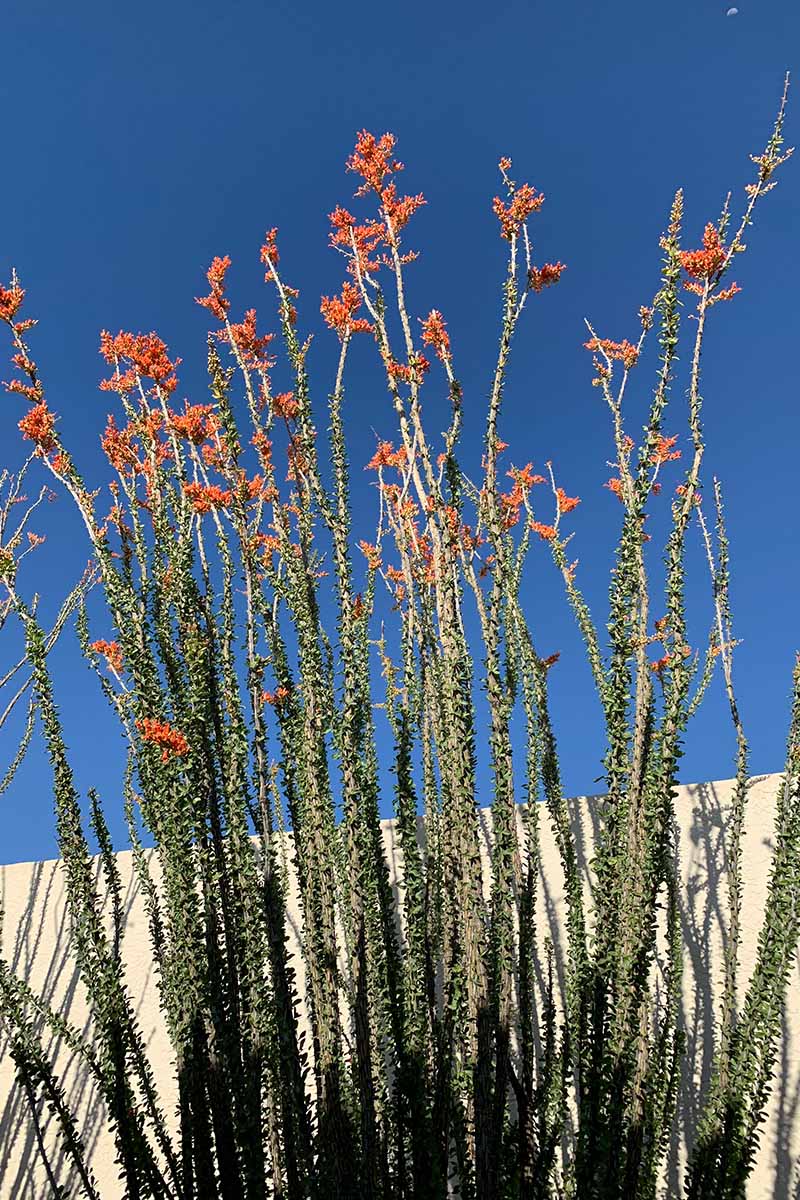
Their native growing range extends from central Mexico north to Arizona, California, New Mexico, and Texas, states along the southwest US border.
They prefer the arid climate and low hillsides of the Mojave, Sonoran, and Chihuahuan deserts, where they can be seen in all their grandeur growing along rivers, desert washes, and floodplains.
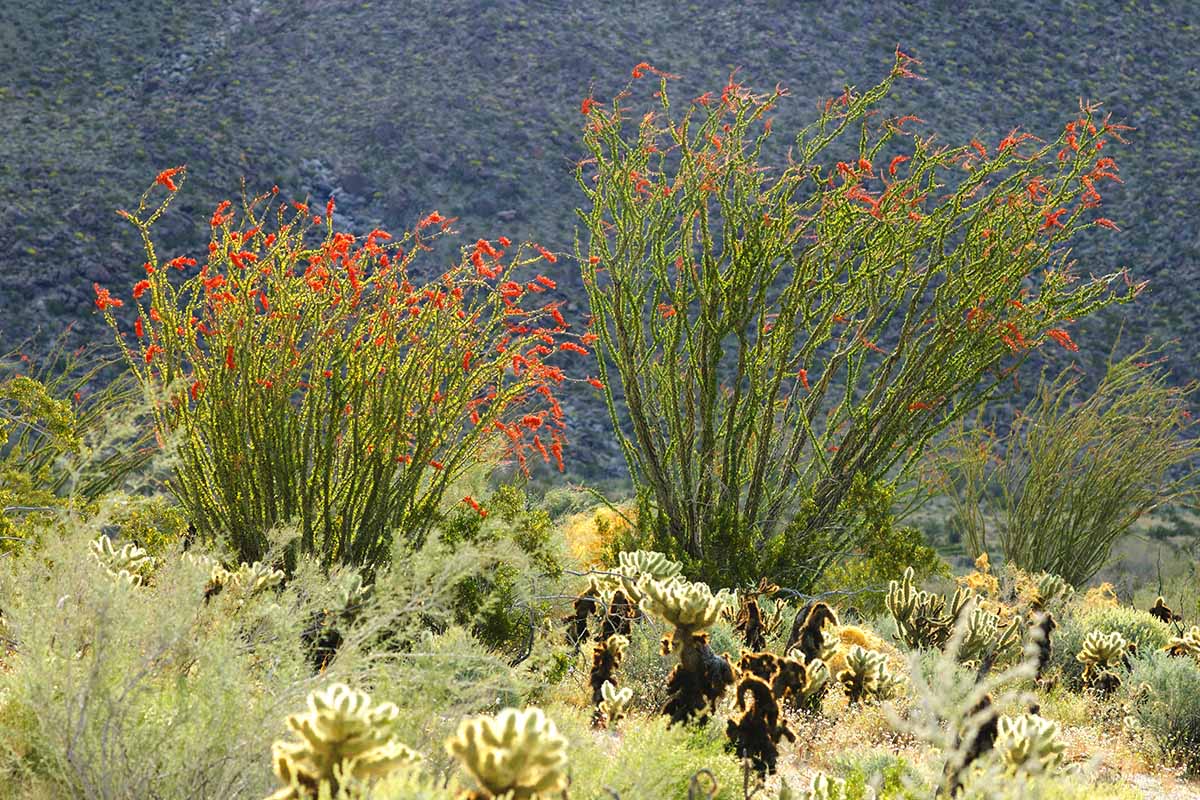
An article published in the Journal of Arid Environments in 2021 highlighting the results of a study of 95 mature ocotillo shrubs over the course of 33 years concluded that the average ocotillo in the wild flowers for 50 years, and support is needed for long-term study over the course of decades pertaining to long-lived desert species.
These multi-stemmed desert plants can reach over 20 feet in height and 15 feet in width under ideal conditions.
Their tall and spiny gray branches lack foliage for much of the year, but when seasonal rains saturate the soil, they respond quickly by setting out bright green leaves that grow above the thorns, covering the spiny branches with foliage.
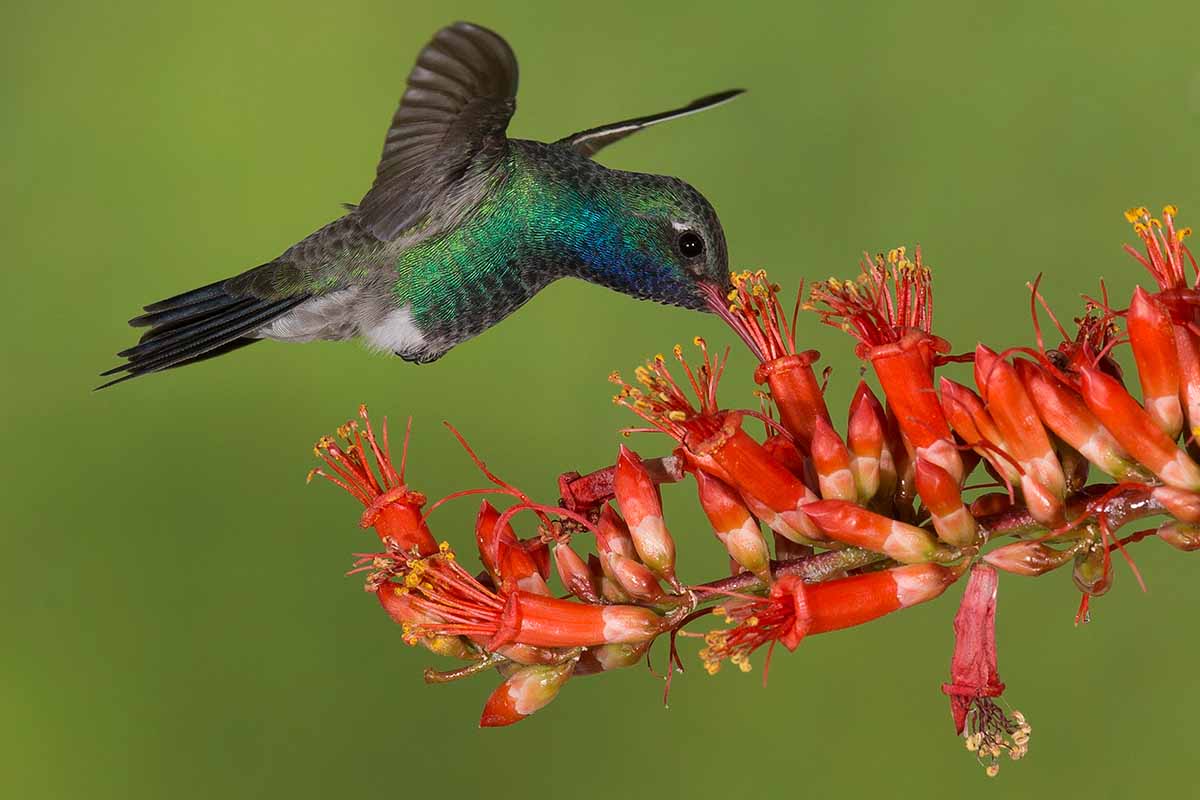
The plant’s reddish-orange tube-shaped flowers bloom in late spring and summer, attracting hummingbirds and bees.
The roots of ocotillo are shallow, which allows them to easily absorb water from infrequent desert floodrains.
Sometimes you can see signs of leaf growth within 24 hours! Considered drought-deciduous, they can repeat this cycle up to five times a year.
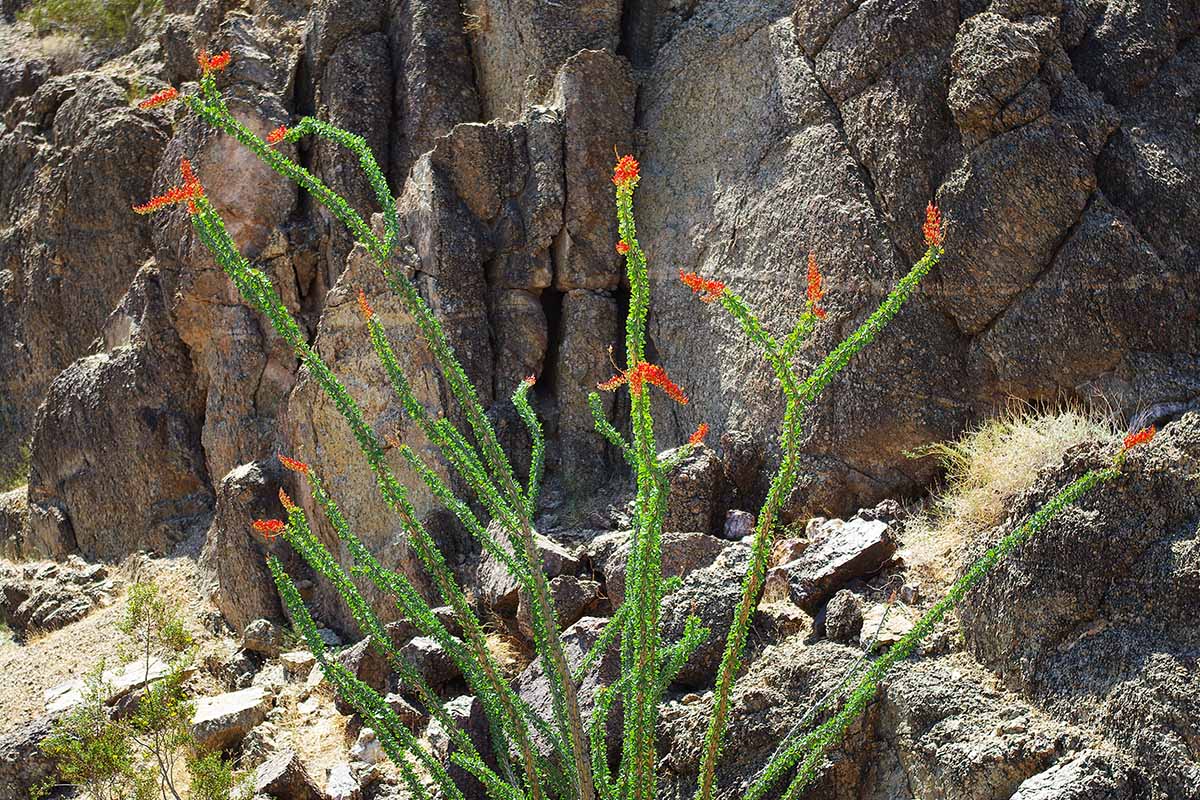
A study published in the American Journal of Botany on F. splendens stem succulence showed that the water stored in stems consistently produced flowers and fruits during the driest years.
Not only is ocotillo intriguing in the way it conserves water, but the plant also plays a vital role in Indigenous culture. Members of Indigenous communities use ocotillo in various ways, for food, medicine, and building material.
The Cahuilla enjoy the fresh flowers by infusing them in water or by eating them raw, and they collect seeds to process them into flour. Branches may be used to create fences.
The root of ocotillo is processed into a powder by the Apache and applied to injuries. And these are just a few highlighted examples of many.
F. splendens is also valued as a medicinal plant in Western herbalism, commonly used as a lymphagogue or treatment that encourages lymph movement.
It may also be used as an expectorant, pelvic decongestant, and as an anti-inflammatory treatment in wound healing.
The results of a study published in the European Journal of Integrative Medicine show that F. splendens contains phenolic compounds with antioxidant and antiproliferative potential for the suppression of malignant cell growth.
Ocotillo is a gorgeous pollinator plant to add to xeriscape garden designs and to include in medicinal gardens!
Propagation
We will cover the two most common ways to propagate ocotillo, from seed and by rooting cuttings. Both methods are promising and will provide you with strong plants!
From Seed
Ocotillo is easy to propagate from seed. If sowing outdoors, springtime is best, but seeds can be started anytime in a warm greenhouse.
Sow seeds in a location with fast-draining soil where they will receive full sunlight. Cactus potting mix can be used to fill containers. Cover the seeds lightly with soil, and tamp it down gently.
Keep the soil warm and slightly moist until they germinate and seedlings emerge, which can take up to two weeks.
From Cuttings
If you have access to a mature plant, you can propagate ocotillo from cuttings instead. Be sure to only harvest cuttings from approved locations or sources.
First, prepare a one-gallon pot with a drainage hole for rooting your cutting, or consider planting your cuttings directly in the ground if you have well-drained soil available.
Fill the pot up with a soil mix suitable for cacti and succulents and water thoroughly before placing your cutting into the soil.
Carefully cut 12 inches of healthy softwood with a clean knife and remove any leaves six inches from the bottom. Dip the cut end in rooting hormone powder.
Stick the branch into the soil, covering the section where the leaves were removed, and tap the soil down around the cutting.
Place your pot in a warm and sunny location. Using a water collecting dish below your container can help to encourage root development, keeping the soil moist.
Water once every two weeks, or increase to once a week if conditions are hot and dry.
Once the plant has produced new leaves, this is an indication that it has developed roots and is ready to be transplanted if it was propagated in a container.
From Seedlings/Transplanting
Rooting cuttings takes a few months, and it will be several years before your seedling or rooted start grows branches like the ones you would see in their natural habitat.
Some patience is required for transplanting ocotillos, but once established, they can thrive for generations. Larger potted specimens may be available from nurseries as well, if you prefer to start with something a bit bigger.
Transplant your ocotillo in early spring. Dig a hole large enough to accommodate the root system in an area that receives full sun with soil that drains readily.
Remember, though moisture is welcome during the propagation phase, too much water can harm this plant’s roots and lead to rot.
Water weekly during summer months and twice per month during cooler weather. It will take six months to two years for the plant to become fully established.
At this point, you can reduce or eliminate routine watering.
How to Grow
This tall, spiny desert shrub is easy to grow when planted in a suitable environment.

Ocotillo prefers a hot and dry climate with exposure to full sun, like that of Zones 8 to 11, and thrives in well-drained soils.
These plants can tolerate temperatures down to about 10°F and they require little to no water once established, making them an ideal species for drought-tolerant gardens.
Very long-lived, these plants can thrive happily for decades with proper care. Always avoid overwatering established plants! Too much water can cause the roots to rot.
Applying fertilizer is unnecessary, and it may discourage flower production if you choose to use it nonetheless. This species is tough and can tolerate harsh arid conditions with little intervention.
Growing Tips
- Grow in hot and dry climates.
- Plant in full sun and well-drained soil.
- Avoid overwatering established plants.
Pruning and Maintenance
When planted in the appropriate location, as with most desert-loving plants, ocotillo requires little to no maintenance.
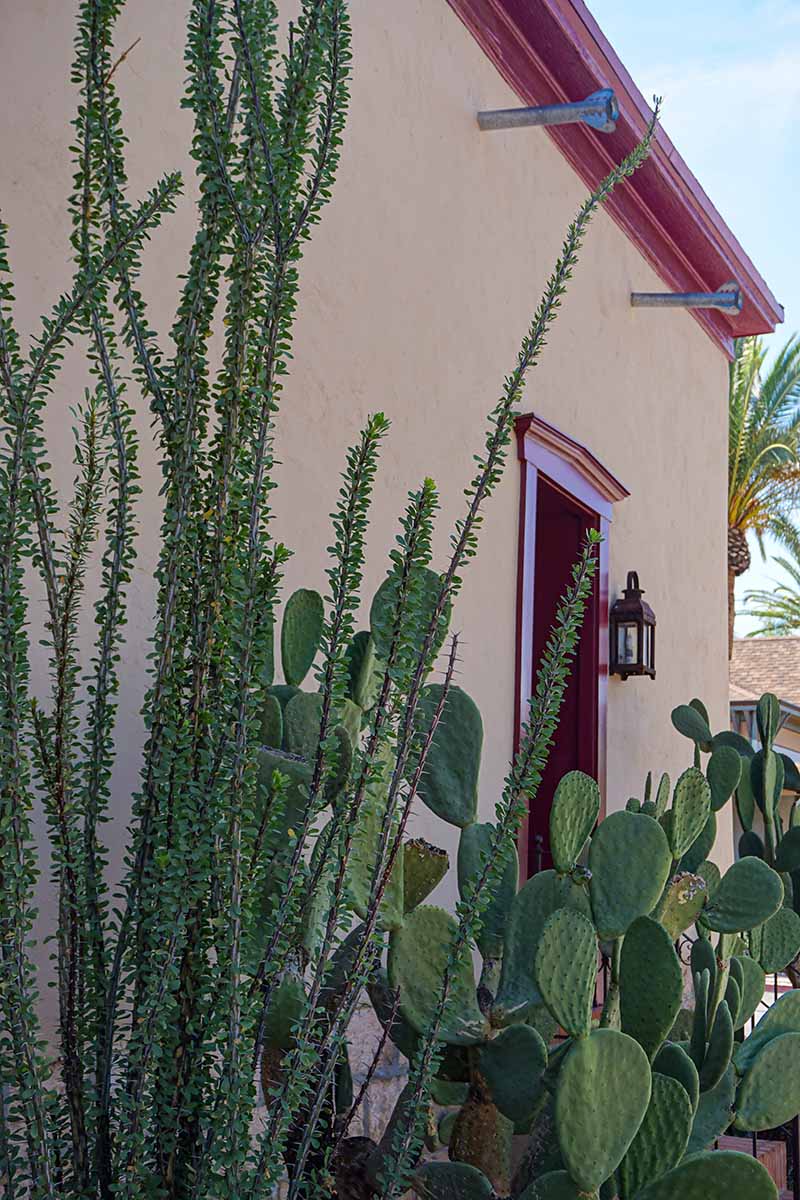
Needless pruning of stems will not allow ocotillo to produce flowers. The only stems that should be pruned are ones that have died or become damaged, or if they’ve grown too tall to suit your space.
Use caution to avoid their strong spikes when pruning them. Wearing tough gloves and using a long-handled lopper is helpful. Cut individual stems down to the ground.
Never top these plants, as that will affect the natural form while stunting overall growth.
Where to Buy
F. splendens is popular in cultivation, and widely available. Be sure to check local nurseries if you live in a desert climate that this plant will enjoy.
The dazzling foot-long flower clusters add a splash of color to landscapes and are enjoyed by pollinators – especially hummingbirds! And who doesn’t love seeing them pay a visit to the garden?
Managing Pests and Disease
Another fantastic trait of this plant is that it is not known to be prone to any diseases in particular, and truly thrives in its native environment.
The only pest to be on the look for is scale. Fortunately these insects are easy to control, particularly if you are able to catch an infestation early.
You can learn more about how to identify and control scale in our guide.
Best Uses
Ocotillo adds to the intrigue of desert gardens with its unique structural form and vibrant flowers that attract hummingbirds and beneficial insects, making it ideal for pollinator gardens.
They pair well with plants like nopal, barrel cactus, and creosote.

Thanks to their strong branches, they can be planted in rows to create fences and they’re excellent for use as defensive plants.
However, their sharp spines can be a safety issue for pets and children, so practice caution when inviting plants with sharp spines into your yard or garden.

This desert species is an excellent choice for gardeners who want to learn more about the medicinal qualities of healing plants that are drought-tolerant and easy to cultivate as well.
Quick Reference Growing Guide
| Plant Type: | Perennial flowering shrub | Flower/Foliage Color: | Reddish-orange/green |
| Native to: | Central and northern Mexico, southwestern United States | Maintenance: | Low |
| Hardiness (USDA Zone): | 8-11 | Tolerance: | Drought, heat, sandy soil |
| Bloom Time/Season: | Spring-summer | Soil Type: | Sandy |
| Exposure: | Full sun | Soil pH: | 7.0-9.0 |
| Time to Maturity: | 2 years (may live 50 years or more) | Soil Drainage: | Well-draining |
| Planting Depth: | Just below surface (seeds), root depth (transplants) | Attracts: | Bees and other flying insects, hummingbirds |
| Spacing: | 10-15 feet | Uses: | Defensive planting, focal point, pollinator garden, xeriscaping |
| Height: | 20 feet | Order: | Ericales |
| Spread: | 15 feet | Family: | Fouquieriaceae |
| Water Needs: | Low | Genus: | Fouquieria |
| Common Pests and Diseases: | Scale, root rot | Species: | Splendens |
An Optimal Water-Wise Option
Ocotillo’s bright pollinator-loving flowers are like fireworks that shoot up from their green and spiny branches. They are impressive additions to xeriscape gardens!
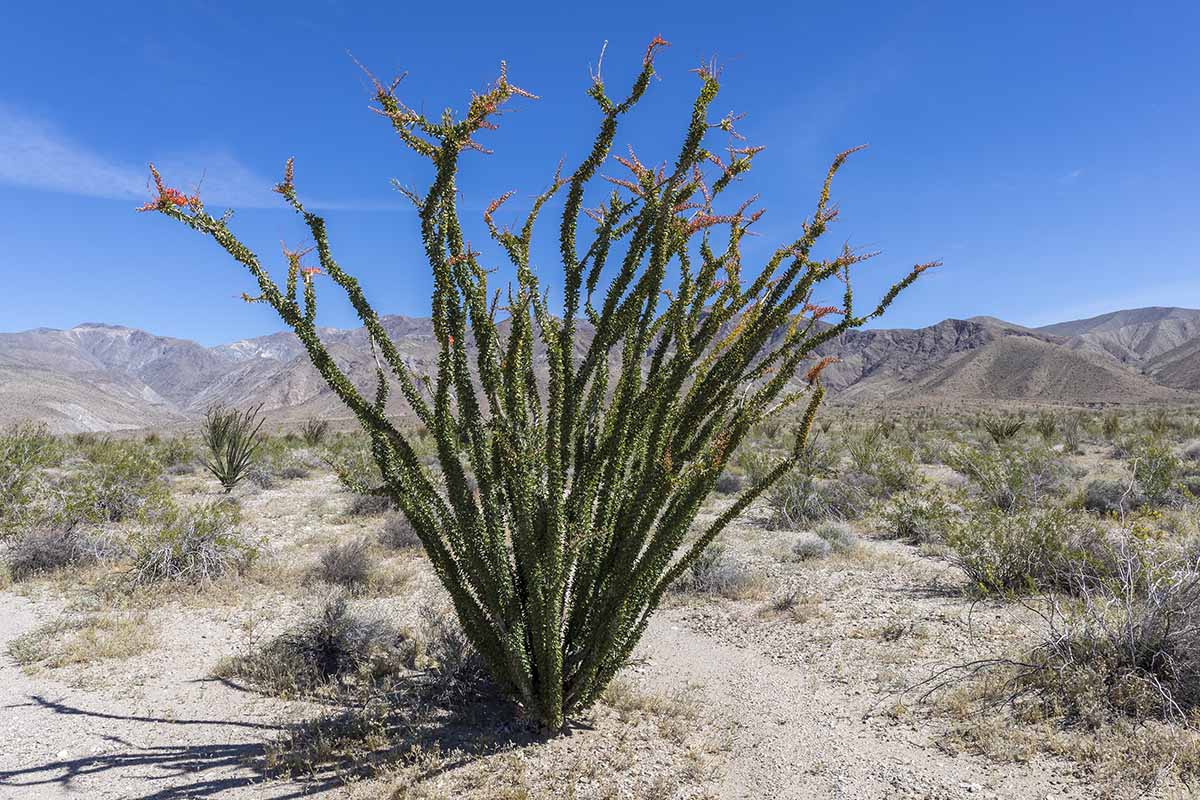
As with many drought-tolerant plants, they don’t require much fuss and prefer to grow wild, making them an appropriate selection for low- or no-maintenance gardens.
I must admit this is one of my favorite desert-dwelling plants. Is ocotillo one of your favs too? This is the place to share your love of plants, so comment below! Feel free to share photos, and any questions you may have as well.
For more inspiration to help you plan the garden of your dreams, check out these drought-resistant desert plant guides next:

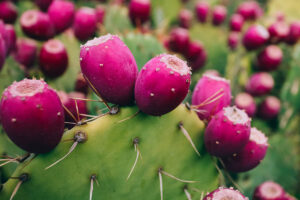

Great informative article on the Ocotillo. Thanks. Here is a picture of one of five I have in my back and front yards. Love them!
Not sure why picture didn’t attach to comment??? Will try again.
Thanks for sharing, William. I was able to retrieve your photo- beautiful!
I absolutely love this plant! I have 4 in pots on my patio!
Thanks for reading Rayanne!
We have a single ocotillo that is growing with an odd sweep to one side and with other random branch positions as shown in are attached photos. Can I train it to grow more upright by staking/tying, or is it just going to grow whichever way it wants? Was this planted incorrectly or could there be something else going on? It was planted in January 2023 and had not produced any leaves. Minimal flowering on only a few branches this past spring.
Hey there, Mike!
Have you considered replanting the ocotillo so that it fits better with your landscape? Don’t worry too much about the lack of leaf growth since you planted it. It’s normal for ocotillos to take a few years to really establish themselves. This might just be the perfect time to replant it!
Thanks for the informative article. It’s also a disappointing article, as I was hoping to try and spread around a few cuttings on our rarely visited desert property of the native ocotillo. I might try spreading lots of seeds in hopes a few might establish themselves.
Hello Aaron, thanks for writing to Gardener’s Path. I understand it probably wouldn’t work out to plant cuttings somewhere you don’t visit that often since they do need consistent care until established.
I would encourage you to try to start some seeds in pots, or perhaps find a local who would be willing to share a few cuttings next time you’re in an area with native ocotillo. You may be able to propagate potted plants and later transplant them to your property.
The directions are in the propagation section, above.
In any case, good luck and thanks for reading.
Interested in planting an ocotillo in my cactus garden. I live in the High Desert CA
Good luck with your new ocotillo Kimberley! Let us know if you have any questions. Happy gardening!
Hello, new to Tucson. I’ve inherited.citrus trees and 2 huge ocotillos. Moved here in April 2023, my ocotillos are flowering but there are no green leafs to speak of even this year. I’ve heard there pretty much maintenance free. Can anyone help
Hi Ben, I wouldn’t worry about it. They tend to only leaf out after a good, heavy period of rain and then the leaves drop off when things dry out again. They might come back again later in the year, or they might not. I’ve seen them leaf out six or seven times in one year and never in others. If the canes feel pliable, they’re alive. No need to do anything.
Hello. I have three separate, small ocotillo cuttings. One has rooted in a pot. I am hoping the other do as well. Assuming they do, do I plant all three in the ground closely together to grow as one plant? Also, when do I plant them? Meaning, now that one has rooted, could I plant it in the ground now? Thanks!
Hi Samantha, it’s up to you if you want to plant them close together or further apart. One cutting will eventually spread over ten feet wide, but it takes time. If you want a closer cluster sooner, plant them close together. I would wait until the weather is cool to transplant them. You can transplant them once they’ve developed roots, but I like to wait until they’ve had roots for several months before planting.